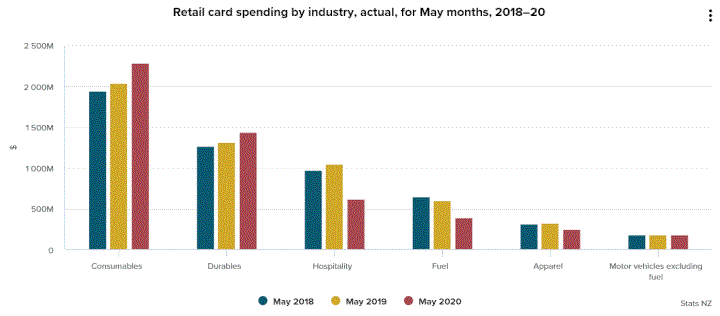Card spending partially rebounds from April’s record low
Retail card spending bounced back by $2.3 billion in May
from extremely low levels in April as businesses re-opened
after the COVID-19 level 4 lockdown, Stats NZ said
today.
“Spending on groceries, furniture, and appliances in May was even higher than the same month last year, but sales for hotels, motels, cafes, and restaurants remained well below typical levels,” retail statistics manager Kathy Hicks said.
“The significant jump in retail spending in May was not unexpected. The partial recovery was a direct result of more businesses re-opening after sales fell drastically when non-essential businesses closed under alert level 4 in April.”
In actual terms, retail spending using electronic cards reached $5.2 billion in May 2020, down $332 million (6.0 percent) from May 2019.
Only two of the six retail industries had increased spending. Spending on consumables (groceries) and durables (furniture, hardware, appliances, and recreational goods) was up from May 2019.

Strong supermarket spending on food and drink
Grocery and liquor (consumables) had the largest increase, up $254 million (12 percent) compared with May 2019.
“Supermarkets and grocery stores were open as an essential service throughout the lockdown and have seen strong consumer spending,” Ms Hicks said.
Increase in spending on long-lasting goods
Spending on furniture, hardware, appliances, and other durables had the next largest increase, up $122 million (9.3 percent) compared with May 2019.
“Kiwis have enjoyed the loosened restrictions to spend on homewares, DIY and winter supplies,” Ms Hicks said.
Spending on furniture, electrical, and hardware goods surges has a more detailed breakdown on durables card spending data.
Hospitality spending lags behind
Spending on eating out (food and beverage services) and hotels, motels, and other accommodation (hospitality), had the largest fall, down $428 million (41 percent).
“Under level 3 in early May, cafes and restaurants could sell meals through contactless takeaways or home deliveries,” Ms Hicks said.
“Under level 2 in the second half of May, customers could dine in, though social distancing measures restricted the number of seats available, so most were still operating below normal levels.
"The border remained closed to international visitors in May, which also hit hospitality spending.”
Fuel spending remains in low gear
Fuel sales were down $210 million (35 percent) in May 2020, compared with May 2019.
“The restrictions on non-essential travel within New Zealand in the first half of May under level 3, together with lower pump prices, saw lower spending on fuel,” Ms Hicks said.
The COVID-19 data portal also shows weekly traffic counts and fuel supply volumes were recovering but lower than normal in May.
Key travel restrictions and COVID-19 Alert System timeline:
19 March 2020: New Zealand’s borders closed to almost all travellers, except for returning New Zealanders.
23 March 2020: New Zealand enters COVID-19 alert level 3
25 March 2020: New Zealand enters COVID-19 alert level 4
27 April 2020: New Zealand enters COVID-19 alert level 3
13 May 2020: New Zealand enters COVID-19 alert level 2
The Government Statistician
authorises all statistics and data we publish.
For
more information about these
statistics:
• Visit Electronic card transactions: May
2020
• See Spending on furniture, electrical, and
hardware goods surges
• See CSV files for
download


 Tax Justice Aotearoa: Overwhelming Support For Capital Gains Tax Welcomed
Tax Justice Aotearoa: Overwhelming Support For Capital Gains Tax Welcomed University of Canterbury: New Flood Technology To Prepare Communities
University of Canterbury: New Flood Technology To Prepare Communities  Bill Bennett: Chorus Fibre Data Surge Marks End Of 2024
Bill Bennett: Chorus Fibre Data Surge Marks End Of 2024 Glenn Banks & Regina Scheyvens, The Conversation: Luxon Goes All Out For Growth In Mining And Tourism – We Should Be Careful What He Wishes For
Glenn Banks & Regina Scheyvens, The Conversation: Luxon Goes All Out For Growth In Mining And Tourism – We Should Be Careful What He Wishes For Hugh Grant: 4 Common Mistakes Businesses Make When Launching Their Online Brand (and How To Avoid Them)
Hugh Grant: 4 Common Mistakes Businesses Make When Launching Their Online Brand (and How To Avoid Them) NZ Association of Scientists: Science System Advisory Group Report Receives Only Selective Engagement From Government
NZ Association of Scientists: Science System Advisory Group Report Receives Only Selective Engagement From Government



